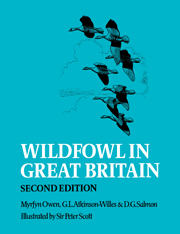Book contents
- Frontmatter
- Contents
- List of location maps
- Foreword by William Wilkinson
- Acknowledgements
- Conventions and abbreviations
- Part I Introduction
- Introduction to the survey
- Wildfowl Counts
- Wildfowl ringing
- Information from shot birds
- Part II The survey of wildfowl habitat and distribution
- Part III Species accounts
- Part IV The conservation of wildfowl and their habitats
- Conclusion
- References
- Indexes
Wildfowl Counts
Published online by Cambridge University Press: 04 August 2010
- Frontmatter
- Contents
- List of location maps
- Foreword by William Wilkinson
- Acknowledgements
- Conventions and abbreviations
- Part I Introduction
- Introduction to the survey
- Wildfowl Counts
- Wildfowl ringing
- Information from shot birds
- Part II The survey of wildfowl habitat and distribution
- Part III Species accounts
- Part IV The conservation of wildfowl and their habitats
- Conclusion
- References
- Indexes
Summary
History and organisation
The Wildfowl Count network was set up in 1947 by the International Wildfowl Inquiry Committee and a Central Organiser was appointed. The aim was to cover as many waters as possible once in each winter month, September – March. The network was made up of volunteer observers and coverage was inevitably incomplete, but special efforts were made to obtain regular counts from the most important sites. The Wildfowl Trust took responsibility for the counts in 1954 and the Organiser (G.L. Atkinson-Willes) moved to Slimbridge. By this time the number of waters counted had risen to more than 500 and about 700 volunteer counters were involved. By the early 1960s more than 2,000 waters had been covered at some time although the average number of counts received was 5–600 in each month.
An International Wildfowl Count scheme was set up by the International Waterfowl Research Bureau at Slimbridge in the mid 1960s, aiming to cover the whole of the western Palearctic range in January each year, and in some years in November or March. When these counts began, with the first full survey in 1967, there was a major impetus to increase the coverage in Britain even further and Regional Organisers recruited more observers. The usual number of counts made in January (the month with most complete coverage) rose to 1,100–1,300 and in other months to 700–900. By 1982, more than 4,000 waters had been covered at some time since 1960 and in the early 1980s more than 1,100 individual counters were involved.
- Type
- Chapter
- Information
- Wildfowl in Great Britain , pp. 4 - 6Publisher: Cambridge University PressPrint publication year: 1986
- 1
- Cited by



